Tag-Along Beekeeping
...
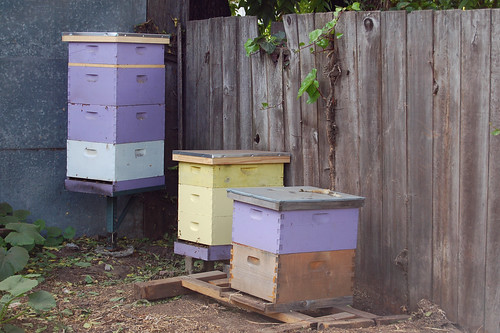
On Saturday, Robb and I visited Stefani's impressive and inspiring garden. I wanted to assist her in doing a bit of beekeeping, and I dragged Robb along so that he could see Stefani's chicken coop. We're pretty certain that we want to get chickens next spring, and the coop that Stefani's husband built is very similar to what Robb has been designing. I thought it would be helpful to see this set-up in action.
Stefani had been given some bee equipment by a friend who wanted to get out of beekeeping. And at some point, a colony of bees had moved into the empty hive boxes. Because there were no frames on which to build honeycomb, the bees started constructing comb on the inside cover of the hive. Stefani had placed this (lavender) hive box on top of another (unpainted) box, in the hopes that the bees might be convinced to move down onto the existing comb inside of the (unpainted) box.
The plan was to carefully detach this comb from the cover of the lavender box, and then rubber-band it into frames. In California, it isn't legal to keep bees in hives that cannot be opened up for inspection. And anyway, it's not good for the bees to have their comb hanging from the ceiling of the hive-box. The comb would be damaged any time the box was opened.

When Stefani opened the hive box, she found the worst possible situation.
The new, soft wax comb had heated up enough to melt, and all of it had fallen away from where it had been previous attached.

Not good.
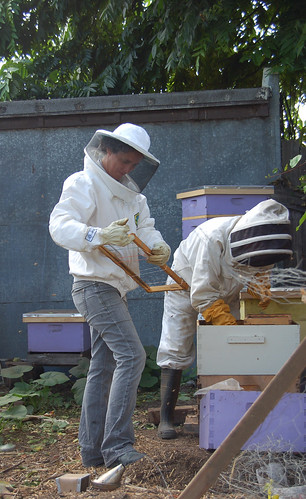
Stefani set to work, separating the mass of comb as gently as she could. And I wrapped frames in rubber bands.
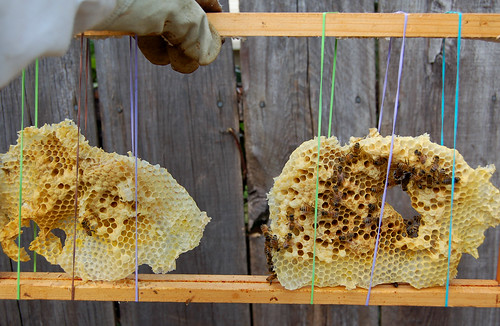
Trying to maintain the original orientation with the broken edge facing up, we slipped the comb between the rubber bands. We hoped the bees would be able to salvage some of their brood.
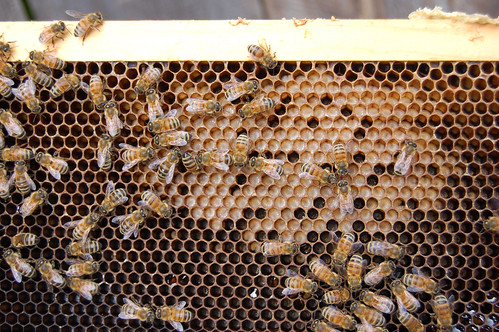
Despite the destruction of the upper comb, the bees had happily accepted the comb that Stefani had provided them in the other hive box. The queen was laying eggs, and larvae was developing. This colony was in good shape.
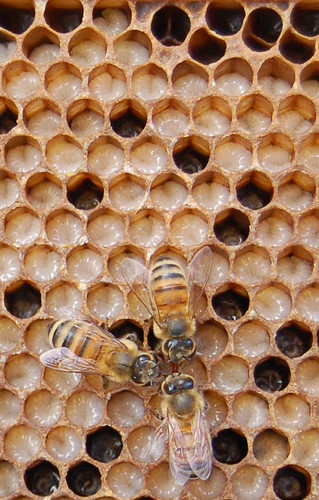
Here's a close-up detail, showing eggs (third cell from the left, bottom row), developing larvae, as well as bees sharing nectar.
These bees are lucky to have Stefani, helping them out. If they were a truly feral colony, with no beekeeper to offer them better housing, the bees might not have been able to recover from the destruction of their comb.
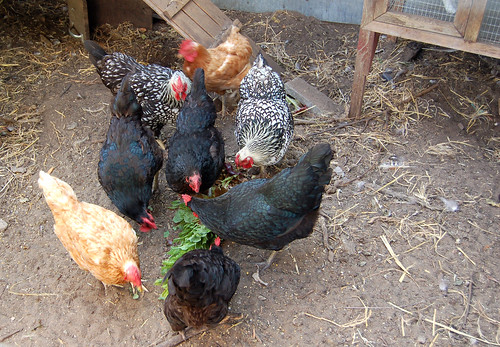
Sadly, some of the brood comb was too badly damaged to salvage. In the spirit of letting nothing go to waste, this was fed to the chickens.
I cannot imagine how anyone takes a non-blurry photograph of feeding chickens. These girls were going crazy for some overgrown lettuce.
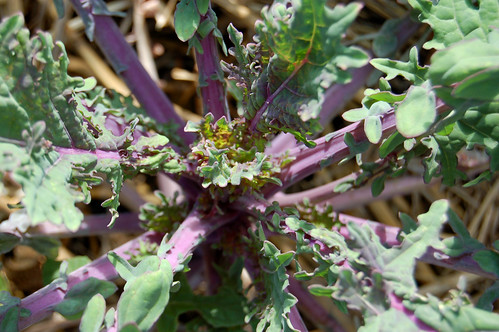
Stefani has an amazing vegetable garden. I was particularly taken with her Russian Kale. We've only grown Lacinato (or "dinosaur") Kale. Perhaps I'll try some of this, next go-around.

Stefani does not seem to have the same snail-and-slug problems that we do. Her strawberries are spectacular, and amazingly delicious. The only predator of the berries seem to be her dogs.
I'm really thankful that Stefani let me tag along with this beekeeping endeavor. I had never done a "cut out" before, and was glad to learn this technique.

On Saturday, Robb and I visited Stefani's impressive and inspiring garden. I wanted to assist her in doing a bit of beekeeping, and I dragged Robb along so that he could see Stefani's chicken coop. We're pretty certain that we want to get chickens next spring, and the coop that Stefani's husband built is very similar to what Robb has been designing. I thought it would be helpful to see this set-up in action.
Stefani had been given some bee equipment by a friend who wanted to get out of beekeeping. And at some point, a colony of bees had moved into the empty hive boxes. Because there were no frames on which to build honeycomb, the bees started constructing comb on the inside cover of the hive. Stefani had placed this (lavender) hive box on top of another (unpainted) box, in the hopes that the bees might be convinced to move down onto the existing comb inside of the (unpainted) box.
The plan was to carefully detach this comb from the cover of the lavender box, and then rubber-band it into frames. In California, it isn't legal to keep bees in hives that cannot be opened up for inspection. And anyway, it's not good for the bees to have their comb hanging from the ceiling of the hive-box. The comb would be damaged any time the box was opened.

When Stefani opened the hive box, she found the worst possible situation.
The new, soft wax comb had heated up enough to melt, and all of it had fallen away from where it had been previous attached.

Not good.

Stefani set to work, separating the mass of comb as gently as she could. And I wrapped frames in rubber bands.

Trying to maintain the original orientation with the broken edge facing up, we slipped the comb between the rubber bands. We hoped the bees would be able to salvage some of their brood.

Despite the destruction of the upper comb, the bees had happily accepted the comb that Stefani had provided them in the other hive box. The queen was laying eggs, and larvae was developing. This colony was in good shape.

Here's a close-up detail, showing eggs (third cell from the left, bottom row), developing larvae, as well as bees sharing nectar.
These bees are lucky to have Stefani, helping them out. If they were a truly feral colony, with no beekeeper to offer them better housing, the bees might not have been able to recover from the destruction of their comb.

Sadly, some of the brood comb was too badly damaged to salvage. In the spirit of letting nothing go to waste, this was fed to the chickens.
I cannot imagine how anyone takes a non-blurry photograph of feeding chickens. These girls were going crazy for some overgrown lettuce.

Stefani has an amazing vegetable garden. I was particularly taken with her Russian Kale. We've only grown Lacinato (or "dinosaur") Kale. Perhaps I'll try some of this, next go-around.

Stefani does not seem to have the same snail-and-slug problems that we do. Her strawberries are spectacular, and amazingly delicious. The only predator of the berries seem to be her dogs.
I'm really thankful that Stefani let me tag along with this beekeeping endeavor. I had never done a "cut out" before, and was glad to learn this technique.

Comments
I have about a cup of kale seeds -- I wish I'd remembered to get them to you.
As always, it was a delight to see both of you. I will come and hang out soon.
This year Todd planted Dinosaur Kale - it has good flavor but yea, I think well go back to the curly stuff.
What a pretty flock Stefani has! Chickens huh? ;-) Cool =)
I haven't tried Russian kale, but I am growing the Dino kale along with a Scotch Blue Curled kale. I think I prefer the Scotch kale to the Dino because it seems more resistant to aphids/mealybugs.
p.s. the word verification on this post is "eflock" which I found fitting.
I have lots and lots and lots of kale seed. I'll get some to you soon.